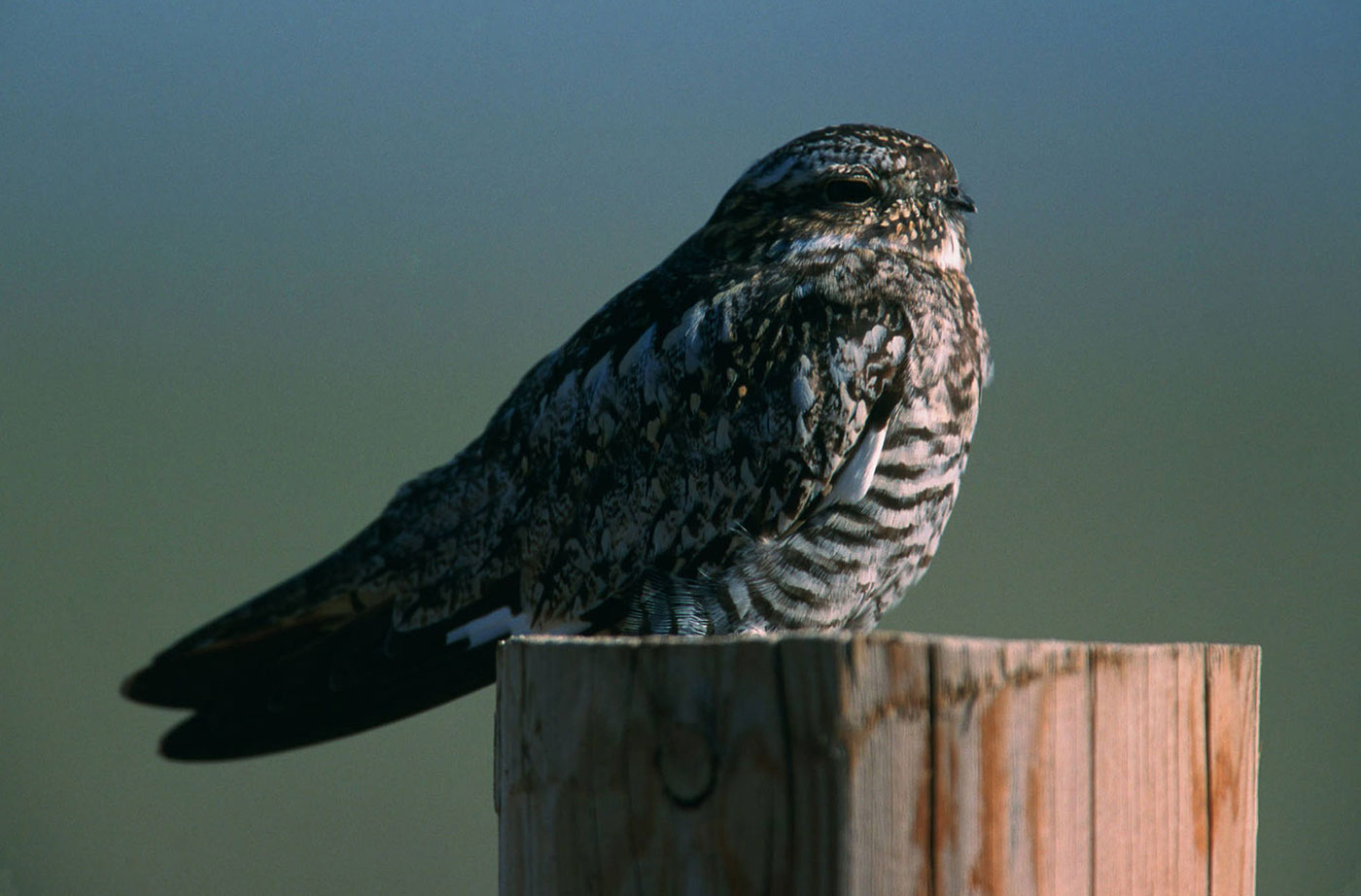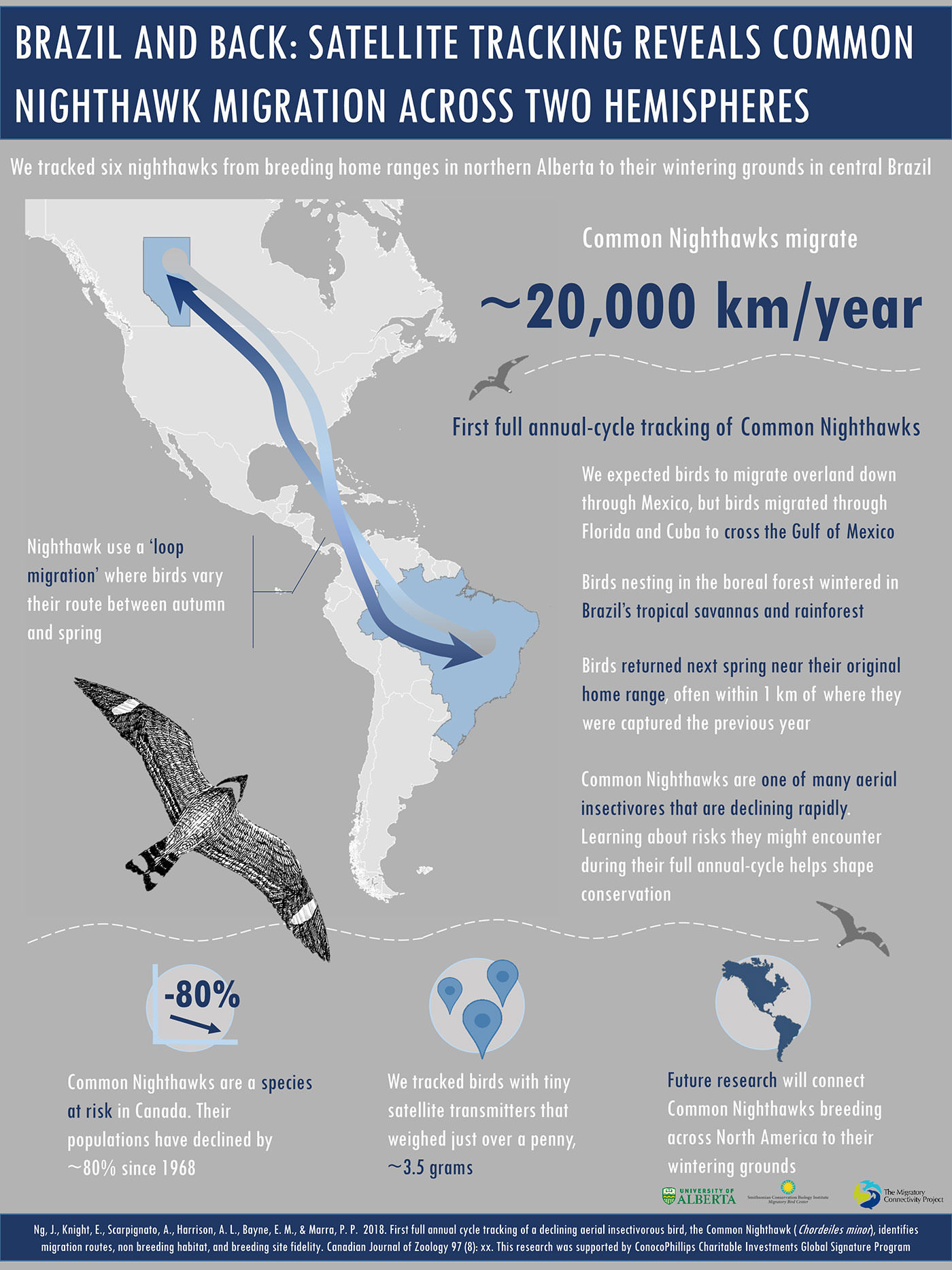Birders in Maine have recently begun noting the first pulses of southbound, migrating Common Nighthawks. In fact, staff at the Natural Resources Council of Maine (NRCM) could very well see one while leaving the office in Augusta after a long day! Based on checklists submitted to eBird, the online database housed at our old stomping grounds, the Cornell Lab of Ornithology, Maine should expect peak numbers any time now (mid to late August).
NRCM is one of many organizations that continue to raise awareness about bird conservation and the importance of protecting the Migratory Bird Treaty Act by declaring 2018 (its 100-year anniversary) the Year of the Bird. The Common Nighthawk is a good species to aim the spotlight on, too, because the species was once relatively common breeders in many Maine cities and towns, nesting on the flat, tar and loose gravel-topped roofs that were the norm decades ago. Across North America, Common Nighthawks have declined by more than 60 percent since the 1960s, with even steeper declines in Maine and across Canada. Today, these birds nest only in small numbers in scattered locations around the state (particularly eastern and northern areas), laying two eggs on the ground in barren, gravelly areas.

Common Nighthawk, USFWS
For years, ornithologists have had a vague sense of Common Nighthawk migration routes and possible wintering areas, given that migrating birds were sometimes seen in the Caribbean and Central America, and that some Common Nighthawks had been collected and occasionally seen in the general Amazon basin region of South America. But such information provided only a general idea of where some birds may go some of the time. We didn’t know, for example, whether birds from certain parts of the nesting range migrated to particular regions to spend the winter.
All that is beginning to change thanks to the work of an ambitious research team focusing on migratory tracking of Common Nighthawks. Led by Janet Ng of the University of Alberta, the first results of the work were published just a few months ago. The team placed tiny units on ten birds from a nesting area in northern Alberta. The units contained a GPS unit that recorded the locations of the birds and periodically sent that information to a satellite where it could be downloaded by the researchers. Seven of the ten units worked (the researchers don’t know what happened to the other three), and five worked throughout the entire year, providing data on southbound migration, wintering areas, and northbound migration.

Mysteries of common nighthawk migration are being revealed thanks to the work of an ambitious research team using GPS units to track the species during migration. (Infographic courtesy of Janet Ng)
The southbound migration of these five Common Nighthawks started in the second week of August, with the birds heading across the U.S. and passing through Florida by September. They dropped down into Cuba and then across the wide expanse of the Caribbean Sea to Venezuela and Colombia, all making it safely to the South American continent by October. They dropped south and east from there, reaching their wintering area in east-central Brazil by November. Because of the pinpoint accuracy of the location data, the researchers were able to study the landscape where the birds spent the winter, showing that it was largely agricultural interspersed with small woodlots.
The birds began their northward journey in March, following a similar route across the Caribbean to Cuba and into Florida, not arriving in the U.S. until early May and not reaching their northern Alberta breeding grounds until June.
The Year of the Bird is a great reminder of how important studies like these are for bird and wildlife conservation. The Natural Resources Council of Maine will continue to work hard to keep wildlife protections in place. We’re also looking forward to seeing more results from other populations of Common Nighthawks that are being studied by this team. Hopefully, we will find out more about why this species is declining and how we can ensure that they are always here for generations of bird lovers to observe, enjoy, and learn from into the future.
The year 2018 marked the 100-year anniversary of the signing of the Migratory Bird Treaty Act (MBTA). It’s because of this treaty that many bird species—including some for which Maine is well known—are still with us rather than disappearing from the earth forever. In honor of this anniversary, the Natural Resources Council of Maine, along with a large coalition of other groups including the National Geographic Society, Birdlife International, the National Audubon Society, the Cornell Lab of Ornithology, and others declared 2018 to be the Year of the Bird. In celebration of this conservation success story, and to put the spotlight on the importance of initiatives such as these, birders Jeff and Allison Wells posted each month in 2018, the “Year of the Bird.”










This article was quite interesting reading. I first became aware of nighthawks in Winnipeg, Manitoba, Canada when I was around 12 o 13. I believed that they nested on the flat roofs of nearby buildings and they became extremely active in the summer evenings, catching bugs on the fly. I found this article on their long journey to South America very interesting indeed, but was sorry to hear that they are declining as are many other birds. Finding the culprits for this decline is something to be researched until the mystery is finally solved. Keep up the good work.
Really nice to hear your memories of them in Winnipeg when they were more common, Donna. The species is now Federally listed as Threatened in Canada and much work like that described in the blog is underway to try to understand what can be done to help increase populations.
That was a great read. I first became aware of the nighthawks while living on the west coast of Florida, in the 1980’s. They would dive down around the freshwater canals toward evening, eating mosquitoes. I’ll never forget the roar as they swooped down. The locals called them bull bats. A few years ago I was on a lake fishing in Princeton, Maine. As evening approached, I spotted two pairs of nighthawks soaring, I was delighted to see them again. I was totally unaware of their migration.
Thank you for sharing your observations, Rick. We hadn’t heard the expression, “bull bats”—interesting! Glad you were able to learn something from our column. Nighthawk migration is quite spectacular, we look forward to catching glimpses of it every year!
I have heard what I think might be this bird’s call around 7pm for the last couple of nights- 03/16 & 03/17. The call is similar to what I understand to be a nighthawk’s for a couple minutes and then interrupted by trilling call that flies back and forth or in loops before going back to the night
Hawk call again. This series repeats itself over and over again several times. can this be a nighthawk so early in the spring?
Thank you for your question, Fred. You are right that it is early for Common Nighthawks. They usually return in late May. What you are most surely hearing is American Woodcock. They are returning in good numbers now. Because they are secretive birds, the best way to know they’re back is by listening for their display, which you nicely describe. Thank you for your interest in birds and for sharing your observation!